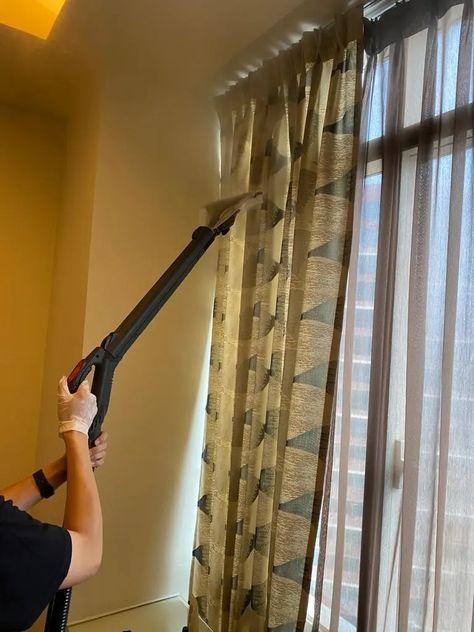Curtains not only enhance the aesthetic appeal of a home but also play a crucial role in filtering light and maintaining privacy. However, they collect dust, allergens, and odors over time, requiring regular cleaning to keep them fresh and hygienic. Cleaning curtains isn’t a one-size-fits-all process—different fabrics require specific care techniques to prevent damage. In this guide, we’ll explore the best curtain cleaning methods based on fabric type and expert recommendations to keep your drapes looking their best.

Understanding Different Curtain Fabrics and Their Cleaning Needs
Before diving into cleaning methods, it’s essential to identify the type of fabric your curtains are made from. Each material has unique properties that determine the best cleaning approach.
1. Cotton Curtains
Cotton is one of the most common and durable curtain fabrics. It can generally withstand frequent washing but may shrink if not handled properly.
-
Cleaning Method: Machine wash with cold water and mild detergent on a gentle cycle.
-
Drying Tips: Air dry to prevent shrinkage or use a low-heat setting in the dryer.
-
Ironing: Use medium heat to remove wrinkles.
2. Linen Curtains
Linen is lightweight and breathable but prone to wrinkles and shrinkage.
-
Cleaning Method: Hand wash in lukewarm water with mild detergent or use a delicate machine wash cycle.
-
Drying Tips: Lay flat or hang dry to maintain the fabric’s natural texture.
-
Ironing: Iron while slightly damp to prevent creases.
3. Velvet Curtains
Velvet curtains add a luxurious touch to interiors but require special care to maintain their plush texture.
-
Cleaning Method: Dry clean only or use a vacuum with an upholstery attachment.
-
Stain Removal: Blot spills immediately with a damp cloth; avoid excessive water.
-
Maintenance Tip: Regularly shake and brush velvet curtains to keep dust at bay.
4. Silk Curtains
Silk is delicate and easily damaged by water and direct sunlight.
-
Cleaning Method: Dry cleaning is recommended; avoid DIY washing.
-
Maintenance Tip: Keep silk curtains away from direct sunlight to prevent fading.
5. Polyester Curtains
Polyester is a synthetic fabric known for its durability and wrinkle resistance.
-
Cleaning Method: Machine wash in warm water on a gentle cycle with mild detergent.
-
Drying Tips: Air dry or use a low-heat tumble dry setting.
-
Ironing: Use a low heat setting if needed.
6. Sheer and Lace Curtains
Sheer and lace curtains are delicate and prone to damage from rough handling.
-
Cleaning Method: Hand wash or use a delicate machine cycle in a mesh laundry bag.
-
Drying Tips: Air dry to prevent stretching or damage.
-
Ironing: Use a low-heat iron with a protective cloth.
Deep Cleaning vs. Regular Maintenance
Understanding when to deep clean and when to perform light maintenance is essential for preserving curtain longevity.
-
Regular Maintenance:
-
Vacuuming with an upholstery brush attachment removes dust and allergens.
-
Spot cleaning with a mild detergent can address minor stains.
-
Shaking curtains outdoors helps remove loose debris.
-
Deep Cleaning:
-
Should be performed every 3 to 6 months, depending on environmental exposure.
-
Professional cleaning is recommended for delicate fabrics like velvet and silk.
-
For washable fabrics, follow proper drying techniques to maintain shape and texture.
Best Practices for Curtain Cleaning
To ensure your curtains remain in top condition, follow these expert cleaning tips:
-
Read the Care Label: Always check the manufacturer’s instructions before cleaning.
-
Avoid Harsh Chemicals: Use gentle detergents and avoid bleach, which can weaken fibers.
-
Test a Small Area: Before applying any cleaning solution, test on a hidden part of the fabric.
-
Use Steam Cleaning for Heavy Drapes: Steam cleaning is a great way to refresh heavy curtains without full immersion in water.
-
Store Curtains Properly: If storing curtains, keep them in a cool, dry place to prevent mold growth.
When to Hire Professional Curtain Cleaners
While DIY cleaning works for many fabric types, professional cleaning is advisable in certain cases:
-
For delicate fabrics like silk, velvet, and lace that require specialized treatment.
-
For large and heavy drapes that are difficult to handle at home.
-
For deep stain removal and odor elimination, especially in homes with pets or smokers.
-
If you suffer from allergies, professional cleaning ensures allergens and dust mites are completely removed.
Conclusion
Proper curtain care extends their lifespan, enhances home hygiene, and maintains their visual appeal. Whether your curtains are made of cotton, linen, silk, or polyester, using the right cleaning techniques prevents damage and keeps them looking fresh. While regular maintenance can be done at home, delicate and heavy drapes may require professional blinds cleaning for optimal results. If you want spotless and long-lasting curtains, following these expert cleaning techniques will ensure they remain in pristine condition year after year.



